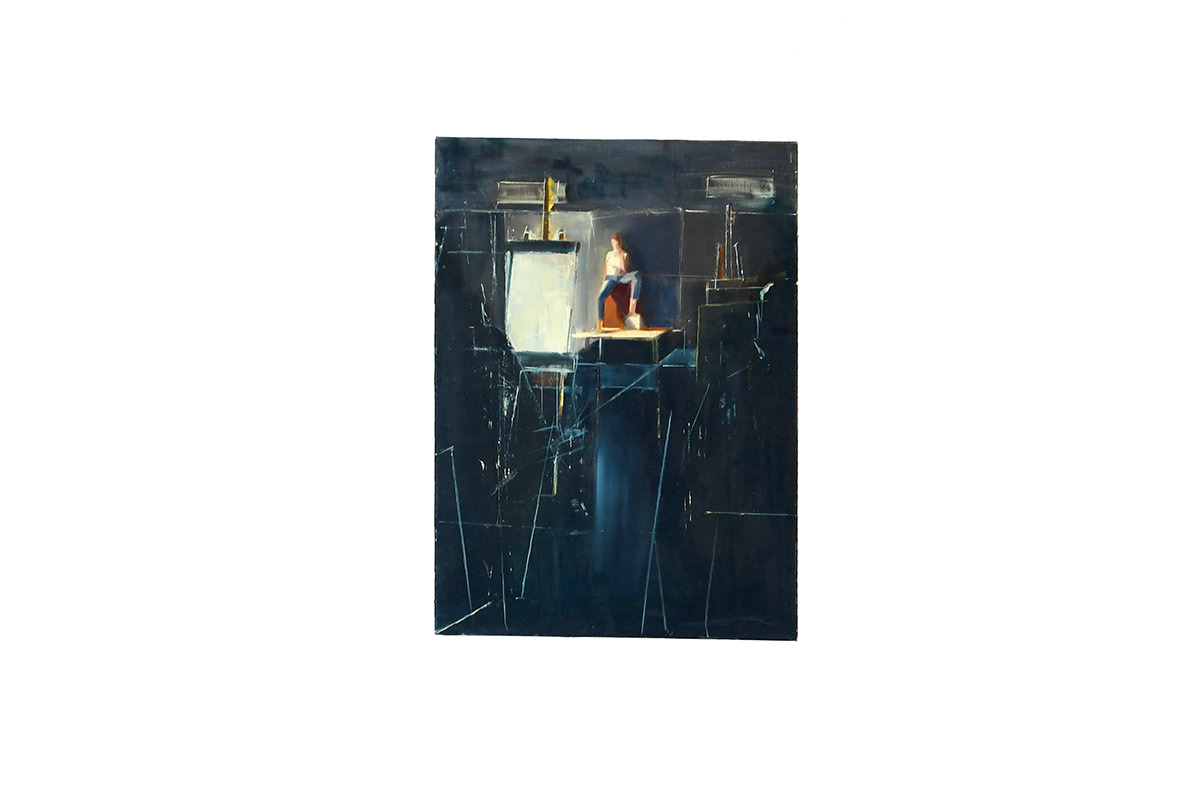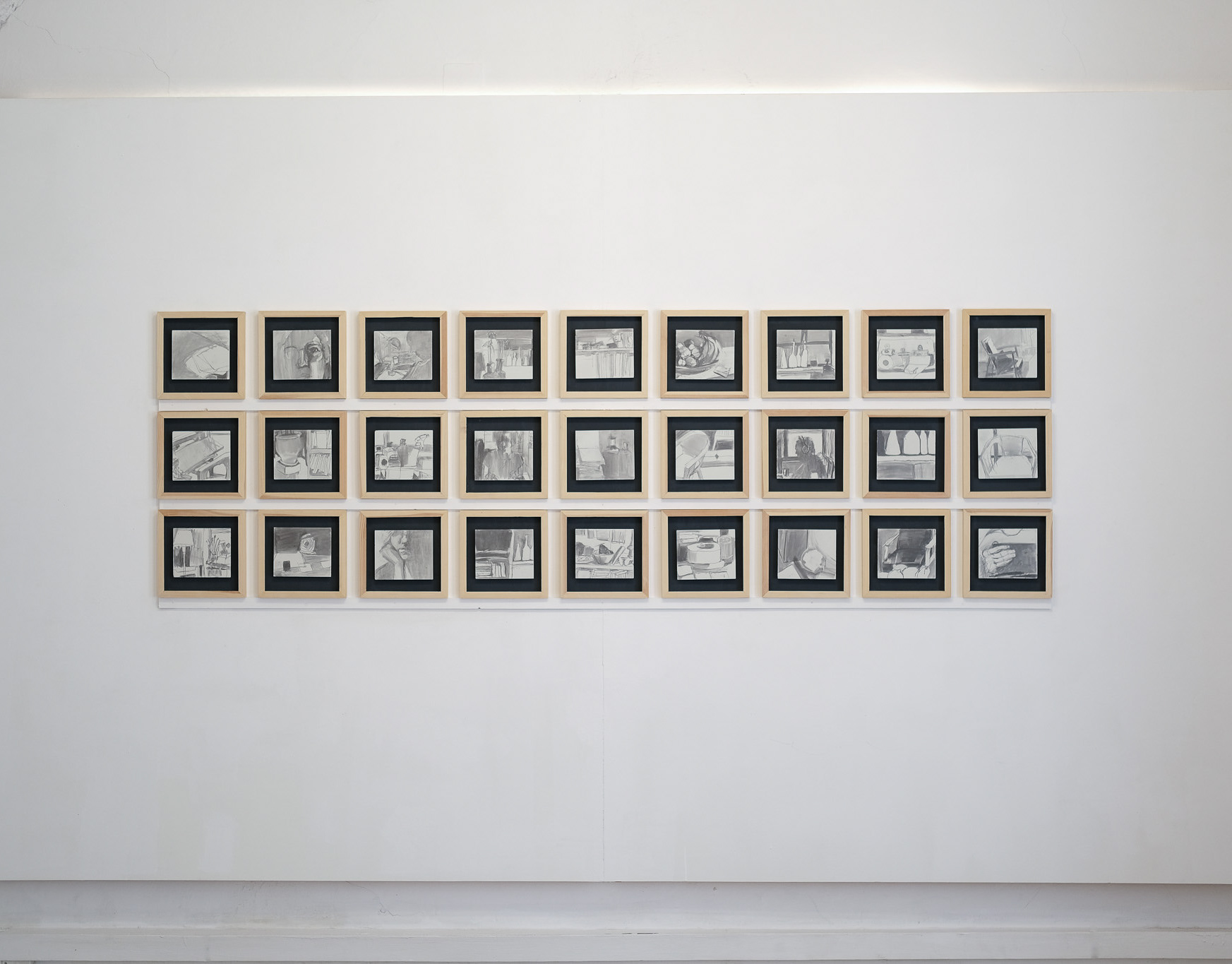As Far as I can see | Solo exhibition
Curator: Avital Wexler
April 2021
Many of the works in the exhibition As far as I can see were created in the days of uncertainty of the coronavirus pandemic, when one could rely on staying at home and the only possible thing to do was to closely observe its contents. This step back from any pretension to grasp reality to the fullest, together with sustained observation, gave the exhibition its name. Yael Boverman-Attas’s exhibition presents works from the last few years: prints in a variety of techniques, from dry point, to etchings, aquatints, monoprints, collagraphs, and lithographs, as well as oil paintings and drawings. Her professional background as a graphic designer is present in the careful aesthetic lines, inner calm, and the intelligent compositions, alongside an obvious internal voice to which she devotes herself.
Devotion is a quality characterizing Boverman-Attas’s work processes, no matter whether she is painting or printing. She is passionate to get to know the bend in the road between rocks as deeply as possible, the rhythm of the tree trunks in the grove, the way in which light touches an exposed abdomen, or the relationship between a gazelle and its shadow. It makes no difference whether it is an inquisitive devotion aimed at decoding the morphological language, such as the relationship between light and shadow, and other elements, or an emotive devotion that perhaps seeks to expose hidden layers in what appears as a reality open to view. Such devotion leads her through an extended process to be precise, to exhaust and abstract reality and expose its core.
Devotion is a quality characterizing Boverman-Attas’s work processes, no matter whether she is painting or printing. She is passionate to get to know the bend in the road between rocks as deeply as possible, the rhythm of the tree trunks in the grove, the way in which light touches an exposed abdomen, or the relationship between a gazelle and its shadow. It makes no difference whether it is an inquisitive devotion aimed at decoding the morphological language, such as the relationship between light and shadow, and other elements, or an emotive devotion that perhaps seeks to expose hidden layers in what appears as a reality open to view. Such devotion leads her through an extended process to be precise, to exhaust and abstract reality and expose its core.
Besides the search associated with location as a theme, the works also conduct journeys through time and mediums. Charcoal or pencil drawings stashed in portfolios for some time have the good fortune to become an etching or a drypoint print, and after an additional rest period, the print may be used as the starting point for an oil painting.
The artist returns and reviews the images born out of an extended observation of a slice of Jerusalem nature, a human model, or the placement of a still life. The images undergo a visible process from the initial moment of observation through the final link in the chain of variations as they become independent and begin to sever themselves from their original backdrop. The careful artificiality that characterizes the arrangement of a still life or the posing of a model, with its drama, painstaking lighting, and deliberate color scheme - all of these elements increasingly dissolve into the process that the artist facilitates for the images to undergo until a new scene forms.
The compositions are gradually unraveled in the process of abstraction and release in which the relationships between shapes, lines, and patches, and the emotions arising at a second and third glance, are the prism through which the artwork comes into being.
The artist returns and reviews the images born out of an extended observation of a slice of Jerusalem nature, a human model, or the placement of a still life. The images undergo a visible process from the initial moment of observation through the final link in the chain of variations as they become independent and begin to sever themselves from their original backdrop. The careful artificiality that characterizes the arrangement of a still life or the posing of a model, with its drama, painstaking lighting, and deliberate color scheme - all of these elements increasingly dissolve into the process that the artist facilitates for the images to undergo until a new scene forms.
The compositions are gradually unraveled in the process of abstraction and release in which the relationships between shapes, lines, and patches, and the emotions arising at a second and third glance, are the prism through which the artwork comes into being.
Boverman-Attas frequently depicts the local landscape, the groves of Jerusalem, which are at times wintry, with a few trees and several rocks. In her forays into nature, the artist chooses to seek out new meaning in the same spots familiar to her from childhood, a new way to capture the light or the spaces between rock and tree, as if searching for an elusive pathway that has not yet been revealed within the familiar landscape. The result hints at a kind of visual haiku, precision that leaves only the essentials extracted from all of the details, textures, and colors.
Concurrently, she examines how the material behaves in the artistic action, taking pleasure in the uncontrollable aspects of the printmaking process which are examined in relation to the careful planning in which she excels as an experienced graphic designer. She draws spontaneously on copper, aluminum, or Plexiglas plates to create monoprints (unique prints) open to unexpected patches of ink and surprising oddities. She also invents combinations of chance elements such as vinyl or organic and other materials, which she combines in a technique that preserves ancient, well-established traditions.
Over the years, Boverman-Attas and her family enjoyed the opportunity for several extended stays in the UK and the USA. These periods abroad enabled her to refresh her gaze and observe unfamiliar landscapes. Each stay is an opportunity seized by the artist to study with local masters and gain experience in new techniques. In her last trip prior to the current pandemic, Boverman-Attas participated in an artist residency program at the Kala Art Institute, in Berkeley, California. During the intensive program, she was able to experiment with unique printing techniques which facilitated the artist’s delicate dance between planning and spontaneity.
Concurrently, she examines how the material behaves in the artistic action, taking pleasure in the uncontrollable aspects of the printmaking process which are examined in relation to the careful planning in which she excels as an experienced graphic designer. She draws spontaneously on copper, aluminum, or Plexiglas plates to create monoprints (unique prints) open to unexpected patches of ink and surprising oddities. She also invents combinations of chance elements such as vinyl or organic and other materials, which she combines in a technique that preserves ancient, well-established traditions.
Over the years, Boverman-Attas and her family enjoyed the opportunity for several extended stays in the UK and the USA. These periods abroad enabled her to refresh her gaze and observe unfamiliar landscapes. Each stay is an opportunity seized by the artist to study with local masters and gain experience in new techniques. In her last trip prior to the current pandemic, Boverman-Attas participated in an artist residency program at the Kala Art Institute, in Berkeley, California. During the intensive program, she was able to experiment with unique printing techniques which facilitated the artist’s delicate dance between planning and spontaneity.
The view from their window in Berkeley with its dense bamboo stalks, inspired a series of prints. The same pattern created by the bamboo then appears in her paintings of interiors, and it seems that the dialogue between the curtain and the floor lamp delineates the same verticals moving between the organic and the architectural.
Due to Corona, Boverman-Attas began to make art within the confines of her home after many years of artistic development in diverse spheres. The lockdowns enabled her artist’s studio to emerge and take form. The living room became a print workshop where she could invent and experiment. After years of painting models and landscapes, “Coronatimes” imposed studio work at home on small formats, at times on improvised surfaces, leading her to select objects of daily life and family members as the subjects of her paintings. The experimental freedom transformed her graphic lines, making them softer and lighter than ever, and it seems that the resulting compositions within the limited space led her to discover all of the hidden beauty spots within the simple and familiar.
When the pandemic imposed various limits, Boverman-Attas managed to transform the temporary limitations into an infinite arena of formal and internal inquiry. The relationships between objects and their surrounding space, between the figures and the furniture, between past and recent works became the personal story about relationships while simultaneously becoming a broader narrative about the hand/eye relationship, the drawing hand and the sentient heart. The exhibition displays a period in the artist’s life and the attentive listener will hear a modest, distinct artistic voice that narrates a story of renewed internal discovery and the ability to draw from within the home a new and broad horizon.
Avital Wexler, Exhibition Curator
Due to Corona, Boverman-Attas began to make art within the confines of her home after many years of artistic development in diverse spheres. The lockdowns enabled her artist’s studio to emerge and take form. The living room became a print workshop where she could invent and experiment. After years of painting models and landscapes, “Coronatimes” imposed studio work at home on small formats, at times on improvised surfaces, leading her to select objects of daily life and family members as the subjects of her paintings. The experimental freedom transformed her graphic lines, making them softer and lighter than ever, and it seems that the resulting compositions within the limited space led her to discover all of the hidden beauty spots within the simple and familiar.
When the pandemic imposed various limits, Boverman-Attas managed to transform the temporary limitations into an infinite arena of formal and internal inquiry. The relationships between objects and their surrounding space, between the figures and the furniture, between past and recent works became the personal story about relationships while simultaneously becoming a broader narrative about the hand/eye relationship, the drawing hand and the sentient heart. The exhibition displays a period in the artist’s life and the attentive listener will hear a modest, distinct artistic voice that narrates a story of renewed internal discovery and the ability to draw from within the home a new and broad horizon.
Avital Wexler, Exhibition Curator










Exhibition Tour Movie
Exhibition Catalog




